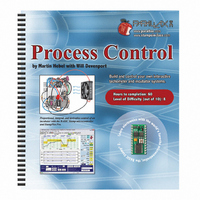122-28176 Parallax Inc, 122-28176 Datasheet - Page 192

122-28176
Manufacturer Part Number
122-28176
Description
GUIDE STUDENT PROCESS CONTROL
Manufacturer
Parallax Inc
Specifications of 122-28176
Accessory Type
Manual
Product
Microcontroller Accessories
Lead Free Status / RoHS Status
Contains lead / RoHS non-compliant
For Use With/related Products
Propeller Education (PE) Kit
Lead Free Status / RoHS Status
Lead free / RoHS Compliant, Contains lead / RoHS non-compliant
- Current page: 192 of 330
- Download datasheet (11Mb)
Page 182 · Process Control
Which is better? Arguably, some people prefer air conditioning to a fan, but others do
not. If the objective is to maintain a comfortable sleeping temperature, they both have
their advantages. In terms of industrial control, the lower cost and simplicity of setting
the window fan in an open-loop mode is very attractive. On the other hand, the automatic
control of the closed-loop air conditioner ensures a more consistent bedroom temperature
as the outside temperature changes.
Determining the best control action for an application and designing the system to
provide this action is what the field of process control engineering is all about.
Microcontrollers have proven to be a dependable, cost-effective means of adding a level
of sophistication to the simplest of control schemes.
Temperature is by far the most common process variable that you will encounter. From
controlling the temperature of molten metal in a foundry to controlling liquid nitrogen in
a cryogenics lab, the measurement, evaluation, and control of temperature are critical to
industry. The objective of this exercise is to show principles of microcontroller-based
process control and enlighten you about interfacing the controller to real-world I/O
devices. The exercises are restricted to circuits that fit on the Board of Education and to
output devices that can be driven by a 9 volt, 300 mA power supply. As you monitor and
control the temperature of a small environment, realize that, through proper signal
conditioning, the applications for which you can apply the BASIC Stamp are limitless.
ACTIVITY #1: TESTING THE LM34
When bringing analog data, such as temperature, into the BASIC Stamp, it is important to
understand the transfer functions involved to properly condition the analog voltage and to
use software to convert that data into something meaningful. The LM34 temperature
sensor supplied with the kits converts a temperature to a voltage with a transfer function
of 0.01 V/°F. At 100 °F, the output will be 1 V. At 80 °F, the output will be 0.8 V and
so on. The LM34-DZ style has a linear output range of 32 to 212 °F. The BASIC Stamp
for monitoring and controlling our system must read this voltage, representing
temperature.
Related parts for 122-28176
Image
Part Number
Description
Manufacturer
Datasheet
Request
R

Part Number:
Description:
MANUAL FOR SUMOBOT
Manufacturer:
Parallax Inc
Datasheet:

Part Number:
Description:
GUIDE STUDENT SMART SENSORS
Manufacturer:
Parallax Inc
Datasheet:

Part Number:
Description:
MANUAL PROPELLER
Manufacturer:
Parallax Inc
Datasheet:

Part Number:
Description:
LEAD WIRES FLYING CABLE III/IV
Manufacturer:
Xilinx Inc
Datasheet:

Part Number:
Description:
BOARD ADAPTER AND FLY LEADS
Manufacturer:
Xilinx Inc
Datasheet:

Part Number:
Description:
PLATFORM CABLE USB II
Manufacturer:
Xilinx Inc
Datasheet:

Part Number:
Description:
KIT STARTER COOLRUNNER-II BUNDLE
Manufacturer:
Xilinx Inc
Datasheet:

Part Number:
Description:
Microcontroller Modules & Accessories DISCONTINUED BY PARALLAX
Manufacturer:
Parallax Inc

Part Number:
Description:
Microcontroller Modules & Accessories DISCONTINUED BY PARALLAX
Manufacturer:
Parallax Inc

Part Number:
Description:
BOOK UNDERSTANDING SIGNALS
Manufacturer:
Parallax Inc
Datasheet:

Part Number:
Description:
BOARD EXPERIMENT+LCD NX-1000
Manufacturer:
Parallax Inc
Datasheet:

Part Number:
Description:
IC MCU 2K FLASH 50MHZ SO-18
Manufacturer:
Parallax Inc
Datasheet:












